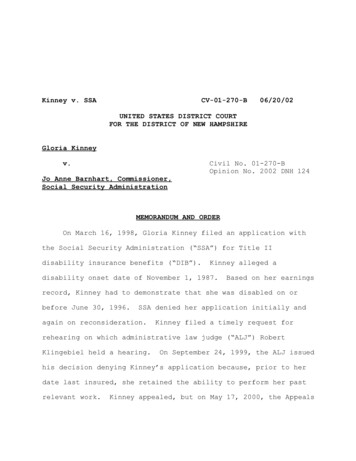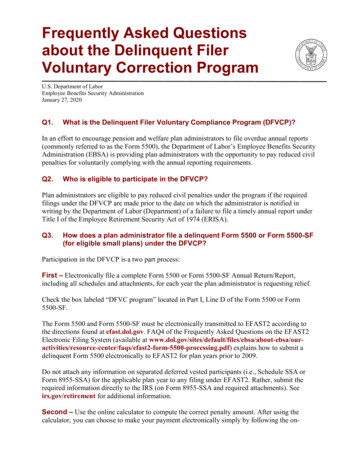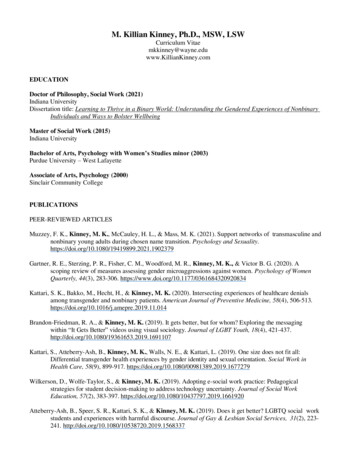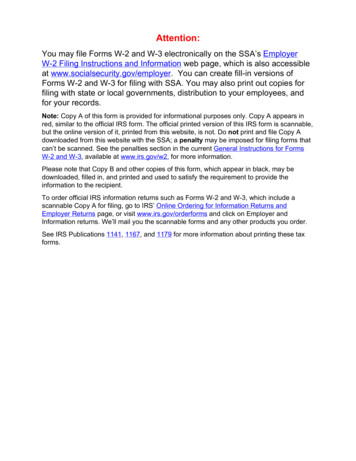
Transcription
CV-01-270-BKinney v. SSA06/20/02UNITED STATES DISTRICT COURTFOR THE DISTRICT OF NEW HAMPSHIREGloria Kinneyv.Civil N o . 01-270-BOpinion N o . 2002 DNH 124Jo Anne Barnhart, Commissioner,Social Security AdministrationMEMORANDUM AND ORDEROn March 1 6 , 1998, Gloria Kinney filed an application withthe Social Security Administration (“SSA”) for Title IIdisability insurance benefits (“DIB”).Kinney alleged adisability onset date of November 1 , 1987. Based on her earningsrecord, Kinney had to demonstrate that she was disabled on orbefore June 3 0 , 1996. SSA denied her application initially andagain on reconsideration.Kinney filed a timely request forrehearing on which administrative law judge (“ALJ”) RobertKlingebiel held a hearing.On September 2 4 , 1999, the ALJ issuedhis decision denying Kinney’s application because, prior to herdate last insured, she retained the ability to perform her pastrelevant work.Kinney appealed, but on May 1 7 , 2000, the Appeals
Council denied her request for review.Accordingly, the ALJ’sdecision became the final decision of the Commissioner of SocialSecurity (“Commissioner”).Kinney brings this action pursuant to 42 U.S.C. § 405(g),seeking review of the denial of her application for DIB.For thereasons set forth below, I deny Kinney’s motion for an orderreversing the decision of the Commissioner, and grant thedefendant’s motion for order affirming the decision of theCommissioner.I . BACKGROUND1A.Work HistoryKinney was born May 2 2 , 1944, and last met the disabilityinsured requirements of the Social Security Act (the “Act”) inJune 1996 when she was 52 years old.Kinney graduated highschool, and has worked as a bookkeeper for a restaurant, and asan office manager for an insurance company and a real estatecompany.Most recently, Kinney worked as an office manager in a1Background facts are largely taken from the JointStatement of Material Facts (doc. n o . 11) submitted by theparties.-2-
dental office from June 1993 to June 1996. Kinney alleges thatfibromyalgia, fatigue, migraine headaches, anxiety and depressionhave prevented her from performing basic work activities sinceNovember 1 , 1987. Kinney’s earnings record shows that she lastmet the insured status requirements of the Act on June 3 0 , 1996.Since her alleged date of onset, Kinney consistently performedsome work on a part-time basis. However, her earnings over theentire period have not, on average, been high enough to renderher employment “substantial gainful activity.”Therefore, Kinneyhas not been “employed” within the meaning of the Act since June1996.B.Medical Evidence Prior to Kinney’s Date Last InsuredOn April 2 3 , 1991, Kinney sought treatment from Dr.Millstein for bilateral shoulder pain that she had beenexperiencing for two months. Upon examination, Dr. Millsteinobserved that Kinney’s pain was intermittent and fairly welllocalized, and was not accompanied by numbness or weakness.Hefurther observed that Kinney experienced some diffuse stiffnessin her hand in the mornings, had a full range of motion in hershoulder without crepitus (grating of a joint), mild tendernessin the biceps tendon anteriorly, a mild decrease in her range of-3-
motion on external rotation, and no neck tenderness over thespinous process. D r . Millstein diagnosed Kinney with leftshoulder pain consistent with tendinitis, and prescribed a trialof the anti-inflammatory Voltaren, along with moist heat.From July 1 2 , 1991 to October 1 7 , 1996, Dr. Robert Swiggetttreated Kinney for symptoms including pain in her left shoulder,stiffness in her right hip, limited motion in her right shoulder,and mid-low back pain without radiation. During Kinney’s initialvisit, Dr. Swiggett observed that Kinney had forward flexion toninety degrees, abduction to eighty degrees, and internal andexternal rotation that was severely limited.Dr. Swiggettdiagnosed her with severe adhesive capsulitis, referred her forphysical therapy, and continued her Naprosyn prescription.During the course of Kinney’s treatment, Dr. Swiggett continuedto prescribe physical therapy.He also prescribed a Medrol dosepack for inflammation, and Clinoril, Relafen, and Flexeril forpain.Kinney underwent manipulation under anesthesia.DuringKinney’s last continuous visit, on September 8 , 1992, Dr.Swiggett noted that her pain was gradually decreasing and herrange of motion increasing.He discharged her to a home therapyprogram and scheduled a followup visit in two months. Kinney did-4-
not return to Dr. Swiggett for over four years.Kinney saw Dr. Larry Pressman on May 1 4 , 1993. He observedslight limitations in Kinney’s shoulder motion bilaterally, thatKinney was in no acute distress, had full range of motion in herhip and knee, and had no focal muscle weakness in her arms orlegs.During this visit, Kinney did not complain of disablingpain and Dr. Pressman’s impression did not include anyrheumatological limitations.Dr. Ernest D’Angelo treated Kinney for headaches fromJanuary 9, 1991 until January 2 5 , 1995. He prescribed Fiorinaland Fioricet for Kinney’s headache pain and Augmentin andDimetapp to relieve the symptoms associated with her sinusitis.On February 2 2 , 1995, D r . D’Angelo noted that Kinney’s diagnosiswas chronic and recurrent headaches.On October 4 , 1993, Dr. Mark Reiner saw Kinney for herheadaches.Dr. Reiner noted that Augmentin helped Kinney’sheadaches, which she had been having three or four times a month.On November 3 0 , 1993, Kinney underwent a CT scan of hersinuses, which came back normal.On February 7 , 1995, Kinney saw Dr. Richard Levy for herheadaches.D r . Levy noted that Kinney had a five year history of-5-
intermittent headaches that were typically bifrontal andsuboccipital and extended into the cervical musculature, and thatshe found some relief with Fiorinal. However, Kinney hadexperienced a headache for an entire month, during which sheexperienced several days of subjective vertigo. Dr. Levy notedthat Kinney’s neurological examination was normal. He diagnosedher with mixed tension type headache and migraine without aura.He prescribed a trial of Phrenilin Forte to relieve the symptomsof her tension headaches and to replace the Fiorinal, whichKinney didn’t like because it contained caffeine.On February 2 4 , 1995, Kinney returned to Dr. Levy with anacute headache.The frequency of her headaches had increased,but she had an excellent response rate (75%) to the PhrenilinForte.D r . Levy’s impression was that Kinney was experiencing acommon migraine with associated muscle tension.D r . Levy notedKinney’s difficult patient behavior, including refusal ofprescriptions and therapies. Out of desperation, Dr. Levyprescribed Kinney Valium.He hoped that the Valium would helpher to sleep and that, as a result, Kinney’s headaches wouldsubside.Kinney acceded to a brain CT Scan.On March 2 , 1995,Kinney underwent a CT scan of her brain, the results of which-6-
were normal.From October 1995 through November 1995, Dr. John Bloomertreated Kinney for shingles. During this time, Kinney alsocomplained of headaches and pain in her right upper quadrant,radiating to her back but not her shoulder.C.Medical Evidence After Kinney’s Date Last InsuredDuring a visit to Dr. Swiggett on October 1 7 , 1996, Kinneycomplained of paracervical discomfort that had been occurring forseveral years. Dr. Swiggett observed that Kinney had diffusetenderness to both trapezii; however, she had a full range ofmotion in her cervical spine and both shoulders, and she had nomotor or sensory deficits in her upper extremities. D r . Swiggettdiagnosed Kinney with chronic myofacial pain.On October 2 9 , 1996, Kinney had a comprehensive physiatricsconsultation with Dr. Gale Brown.During this examination, Dr.Brown noted that Kinney left her work at the dentist office inJune of 1996, when she required treatment for pneumonia.Dr.Brown observed that Kinney’s cervical pain was predominantly withrotation and that, with palpitation, there were multiple triggerpoints involving the cervical extensors, trapezii, levatorscapulae and rhomboids. Dr. Brown diagnosed Kinney with chronic-7-
cervical myofascial pain, significant axial deconditioning, asleep disorder, and possible mood disorder.Dr. Brown prescribedNortriptyline for treatment of depression and eight physicaltherapy sessions.During an examination with Dr. Brown on November 1 5 , 1996,Kinney complained of exacerbating neck pain and headaches.Dr.Brown observed that Kinney’s cervical range of motion was limitedin rotation bilaterally to approximately seventy degrees on theright side and sixty-five degrees on the left side, and that shehad increased posterior cervical pain with cervical rotation tothe left.Kinney’s cervical extension was limited to fortydegrees, her flexion was nearly full, and the range of motion inher shoulder was intact. D r . Brown continued Kinney’s physicaltherapy regimen and prescribed Valium and Trilisate2 to treatpain in her shoulder.Kinney’s last visit with Dr. Brown was on December 6, 1996.On that date, D r . Brown observed tenderness over the cervicalfacet area bilaterally, mildly limited cervical range of motionon rotation and that her neurological examination was intact.2Earlier that month, Kinney refused a prescription forTrilisate from D r . Brown.-8-
Kinney had not tried the Nortriptyline that D r . Brown prescribedin October.Dr. Brown continued to prescribe Trilisate andcontinued with physical therapy, massage, and home exercise.Dr.Brown scheduled a follow-up visit for six weeks later, but Kinneydid not return.On October 3 1 , 1996, Kinney had an X-ray of her cervicalspine, which revealed that Kinney had degenerative changes,especially at C3-4 and C4-5, with posterior spurring and neuralforaminal encroachment that was greater on the right side.On September 3 0 , 1997, D r . Shearman diagnosed Kinney withfibromyalgia and bilateral frozen shoulders.Dr. Humberto Valdes provided Kinney mental health treatmentfrom October 2 1 , 1997 until March 5 , 1998. Kinney revealed thatshe was having problems with her marriage, that she slept foronly about five hours a night, and that she had low energy andhad experienced mood swings for five to six years. Kinney wasdiagnosed with an “Adjustment Disorder, Mixed and SignificantMoodiness,” and it was recommended that she obtain psychotherapy.On June 1 2 , 1998, Craig E . Stenslie, Ph.D., a DisabilityDetermination Services’ non-examining consultant, completed aPsychiatric Review Technique form on Kinney.-9-Stenslie evaluated
Kinney’s condition up until her date last insured, and concludedthere was insufficient medical evidence to establish that shesuffered from a mental impairment.On September 3 , 1998, Dr. John Bloomer completed aFibromyalgia Residual Functional Capacity Questionnaire.Heconcluded that Kinney met the American Rheumatological Societycriteria for fibromyalgia, was suffering from chronic fatiguesyndrome, and opined that her condition was expected to last forat least twelve months. D r . Bloomer noted that Kinney had painbilaterally in her lower back, cervical spine, chest, shoulders,arms, hands/fingers, hips, legs and knees/ankles/feet.Dr.Bloomer also noted that Kinney’s symptoms frequently/constantlyinterfered with her ability to concentrate, and that she wasseverely limited in her ability to deal with work stress. Kinneywas not currently taking any prescription medicines, though shewould take Relafen and Fiormor when needed.Kinney was able tostand/walk for two hours out of an eight-hour day and sit for atleast six hours out of an eight-hour day.D r . Bloomer opinedthat Kinney needed a job that would allow her to shift positionsand take a break every half hour.Dr. Bloomer additionally notedthat Kinney needed to elevate her legs while sitting.-10-Finally,
Dr. Bloomer found that Kinney was limited in her ability to dorepetitive reaching, handling, or fingering, and that she had theability to lift ten pounds only occasionally.On February 2 , 1999, Dr. Robert Rainie, a DisabilityDetermination Services’ non-examining consultant, completed aphysical residual capacity assessment on Kinney.Dr. Rainiefound that Kinney could frequently lift ten pounds, occasionallylift twenty pounds and had an unlimited ability to push and/orpull.Dr. Rainie opined that Kinney could sit, stand, and walkfor six hours out of an eight-hour day.Dr. Rainie thought thatKinney could only occasionally climb, balance, stoop, kneel,crouch and crawl and that she was limited in her ability to reachin all directions.D.Kinney’s TestimonyAt the hearing before the ALJ, Kinney testified that she haspain in her neck and shoulders, that she has migraines,frequently eight times a month, and that she had migraines asfrequently as eight times a month back in 1996. When Kinney hasa migraine it can last two days, during which time she sleeps ina dark room and takes medication.She also has pain in her rightarm, like tennis elbow, and it affects her from her fingertips to-11-
her scapulary.She has had this pain since prior to her datelast insured.Kinney rates her pain as a seven on a ten-pointscale on an average day; however, exertion such as opening awindow can flare her pain to a ten.When her pain flares u p ,Kinney applies a cold pack, takes medication and tries to relax.Kinney testified that, on an average day, she awakensbetween eight and nine in the morning, but that it takes her anhour to get out of bed because her hands hurt and her bones feelas if they are swelling.During the day, Kinney prepares meals,waters the plants, feeds her cats and watches television.Kinneynaps for an hour or two in the afternoon, and sleeps for twohours on a good night.Kinney can dust furniture, unload a dishwasher, wash and dryclothes and go food shopping, but she is unable to lift a basketof laundry or to perform any lifting while shopping.Kinney isable to go out to dinner with friends, though she has to cancelplans about one-third of the time. She goes to the movies threetimes per year, but has difficulty sitting through a two hourmovie.Driving within ten miles of her home is possible, but sheneeds to take at least one break during a two and a half hour cartrip.When paying bills, Kinney has pain in her hand after-12-
writing six checks. Kinney was able to both sit in an elevatedposition and stand for thirty minutes, but she cannot sit orstand for one hour out of an eight-hour day.She can lift agallon of water with both hands, but could not lift this weightover her head.Kinney also testified about concentration and memoryproblems.She has difficulty concentrating on televisionprograms, and finds that her attention wanders after one to twominutes.Kinney also has problems remembering where she parkedher car.Kinney is only able to read for fifteen to twentyminutes before she has to put her book down.E.The ALJ’s DecisionIn his September 2 4 , 1999 decision, the ALJ applied thefive-step sequential evaluation process under which disabilityapplications are reviewed.See 20 C.F.R. § 404.1520. In thefirst step, the ALJ found that Kinney had performed work on apart-time basis since her alleged date of onset of disability;however, her earnings were not high enough to qualify as“substantial gainful activity.”Therefore, the ALJ found thatKinney had not performed substantial gainful activity sinceNovember 1 , 1987. At the second step, the ALJ found that-13-
Kinney’s migraine headaches and fibromyalgia constituted severeimpairments.At the third step, he found that Kinney’simpairments, although severe, did not meet or equal the criteriaof any listed impairment described in 20 C.F.R. § 404, Subpart P,Appendix 1 .In assessing Kinney’s residual functional capacity (“RFC”),the ALJ found that, prior to her date last insured, Kinney couldnot lift and carry more than twenty pounds occasionally or morethan ten pounds frequently; could not stand, walk, or sit formore than six hours in an eight-hour day; and that all posturalactivities were limited to being performed only occasionally.Based on this RFC, the ALJ found at step four of the disabilityevaluation process that Kinney could return to her formeremployment, as it did not require the performance of work-relatedactivities precluded by her limitations. Because the plaintiffwas able to return to her past relevant work, she was not under adisability (as defined by the Act) prior to her date lastinsured.In reaching this conclusion, the ALJ noted that Kinney’streating and examining physicians did not indicate anywhere inthe record that she would be totally disabled prior to the date-14-
last insured.For example, Dr. Brown diagnosed chronic cervicalmyofacial pain, axial deconditioning, sleep disorder and apossible mood disorder.The ALJ pointed out, however, thatKinney’s examination revealed a normal gait and only some painand limitation of motion in the shoulders, a grossly normalneurological examination, and negative rheumatologic examination.Although D r . Bloomer, in a functional capacity questionnairedated September 3 , 1998, noted a functional capacity for lessthan a full range of sedentary work, the ALJ found that D r .Bloomer’s limited notes do not reveal this level of disfunctionprior to Kinney’s last date insured.After a full review of therecord, the ALJ did not give Dr. Bloomers’s opinion full weightbecause it was not supported by the facts of the case, wasrendered twenty months after Kinney’s date last insured, and didnot indicate the period for which it was intended.Finally, the ALJ also found that Kinney’s allegations of adisabling pain and other subjective symptoms were not entirelycredible.Since Kinney’s alleged onset of disability, she soughtmedical treatment only sporadically, with no documentation ofregular medical treatment from 1992 to 1994. He found that herinitial shoulder problems from 1991 to 1992 responded well to-15-
treatment.Relying upon notes from treating physician D r . Brown,the ALJ concluded that while Kinney did experience somelimitations as a result of her impairments, she did notexperience pain or other subjective symptoms at a level thatwould interfere with performing light exertional level workactivity.I I . STANDARD OF REVIEWAfter a final determination by the Commissioner denying aclaimant’s application for benefits, and upon timely request bythe claimant, I am authorized t o : (1) review the pleadingssubmitted by the parties and the transcript of the administrativerecord; and (2) enter a judgment affirming, modifying, orreversing the ALJ’s decision. See 42 U.S.C. § 405(g).My reviewis limited in scope, however, because the ALJ’s factual findingsare conclusive if supported by substantial evidence. See id.;Irlanda Ortiz v . Sec’y of Health & Human Servs., 955 F.2d 765,769 (1st Cir. 1991) (per curiam).The ALJ is responsible forsettling credibility issues, drawing inferences from the recordevidence, and resolving conflicts in the evidence. See Irlanda-16-
Ortiz, 955 F.2d at 769. Therefore, I must “uphold the [ALJ’s]findings . . . if a reasonable mind, reviewing the evidence inthe record as a whole, could accept it as adequate to support[the ALJ’s] conclusion.”Id. (quoting Rodriquez v . Sec’y ofHealth & Human Servs., 647 F.2d 2 1 8 , 222 (1st Cir. 1981))(internal quotation marks omitted).The ALJ’s findings of fact are unalterable unless they are“derived by ignoring evidence, misapplying the law, or judgingmatters entrusted to experts.”(1st Cir. 1999) (per curiam).Nguyen v . Chater, 172 F.3d 3 1 , 35I apply this standard in reviewingthe issues that Kinney raises on appeal.III.DISCUSSIONIn relevant part, the Act defines “disability” as the“inability to engage in any substantial gainful activity byreason of any medically determinable physical or mentalimpairment which can be expected to result in death or which haslasted or can be expected to last for a continuous period of notless than 12 months.”42 U.S.C. § 423(d)(1)(A).The Act directsan ALJ to apply a five-step sequential analysis to determine-17-
whether a claimant is disabled.3See 20 C.F.R. § 404.1520. TheALJ’s determinations at steps one through three of this processare not in dispute, so I proceed directly to step four.At step four of the process, the ALJ must determine whetherthe claimant’s impairment prevents her from performing her pastwork.20 C.F.R. § 404.1520(e).To make this determination, theALJ must assess both the claimant’s residual functional capacity(“RFC”), that i s , what the claimant can do despite herimpairments, and the demands of the claimant’s prior employment.See id.; 20 C.F.R. § 404.1545(a); see also Santiago v . Sec’y ofHealth and Human Servs., 944 F.2d 1 , 7 (1st Cir. 1991) (percuriam).The claimant, however, bears the burden of showing thatshe does not have the RFC to perform her past relevant work.SeeSantiago, 944 F.2d at 5 .At step five, the burden shifts to the Commissioner to show“that there are jobs in the national economy that [the] claimant3The ALJ is required to determine: (1) whether the claimantis presently engaged in substantial gainful activity; (2) whetherthe claimant has a severe impairment; (3) whether the impairmentmeets or equals a listed impairment; (4) whether the impairmentprevents or prevented the claimant from performing past relevantwork; and (5) whether the impairment prevents or prevented theclaimant from doing any other work. See 20 C.F.R. § 404.1520.-18-
can perform.”Heggarty v . Sullivan, 947 F.2d 990, 995 (1st Cir.1991) (per curiam); see also Keating v . Sec’y of Health & HumanServs., 848 F.2d 271, 276 (1st Cir. 1988) (per curiam).TheCommissioner must show that the claimant’s limitations do notprevent her from engaging in substantial gainful work, but neednot show that the claimant could actually find a job.SeeKeating, 848 F.2d at 276 (“The standard is not employability, butcapacity to do the job.”).In this case, the ALJ concluded at step four of thesequential evaluation process that Kinney was able to perform herpast relevant work prior to her date last insured.Kinney arguesthat the ALJ’s decision must be reversed and remanded because itis tainted by legal errors. First, Kinney argues that the ALJviolated Social Security Ruling (“SSR”) 96-2p by failing toexplain the weight given to the opinions of her treatingphysicians, Dr. Bloomer and Dr. Brown.Second, Kinney arguesthat the ALJ failed to adhere to the requirements of SSR 96-7pwhen assessing her credibility.I address these arguments inturn.A.Treating Physicians’ OpinionsKinney argues that the ALJ failed to follow SSR 96-2p in-19-
evaluating her treating physicians’ opinions.Specifically,Kinney contends that the ALJ failed to give specific reasons forhis decision not to give the physicians’ opinions controlling orgreat weight, and failed to adopt all the limitations that thetreating physicians ascribed to Kinney.Controlling weight will be given to the medical opinion of atreating physician where the opinion is “well-supported bymedically acceptable clinical and laboratory diagnostictechniques and is not inconsistent with the other substantialevidence in [the] case record.”20 C.F.R. § 404.1527(d)(2).When a treating physician’s medical opinion is not entitled tocontrolling weight, the ALJ must still determine the appropriateweight to give to the opinion by evaluating certain factors. Seeid.The ALJ must consider: (1) the length of the treatmentrelationship and the frequency of examination; (2) the nature andextent of the treatment relationship; (3) whether and to whatextent the opinion is supported by medical signs and laboratoryfindings; (4) whether the opinion is consistent with otherevidence in the record; (5) whether the physician’s opinionconcerns medical issues related to his area of specialty; and (6)any other factors which support or contradict the opinion.-20-20
C.F.R. § 404.1527(d).1.Dr. Brown’s OpinionKinney argues that the ALJ ignored D r . Brown’s diagnosis ofpain, including the October 1996 statement that “[four] yearsago, [Kinney] began having bilateral neck pain which radiated tothe top of her shoulders.”Kinney also faults the ALJ’s failureto rely upon the following statements found in D r . Brown’srecords: (1) that Kinney experienced “constant bilateral neckpain [with symptoms] aggravated with lifting and reaching forextended periods of time;” (2) that Kinney saw “her symptoms . . continue[] to progress;” and (3) that she has used numerousmedications “without significant benefit.”Kinney also arguesthat the ALJ fails to credit D r . Brown’s diagnosis of chroniccervical myofacial pain.The selected portions of D r . Brown’s November 1996 notes,when analyzed along side Dr. Brown’s complete record, do notsupport Kinney’s conclusion that she suffered from debilitatingpain.For example, the notes state that “her symptoms havecontinued to progress.”grade sinus infection.But, Dr. Brown attributed this to a lowDr. Brown’s November 1996 notes alsostate that Kinney has used numerous medications “without-21-
significant benefit.”However, Kinney had refused arecommendation for Trilisate and, according to the December 1996notes, did not try the nortriptyline that Dr. Brown prescribed inOctober 1996. The ALJ found that D r . Brown’s transition to anindependent exercise program, a limited period of massage and useof Trilisate as needed, with no discussion of additional symptomrelief measures, did not support a claim of debilitating pain.Regarding Dr. Brown’s diagnosis of myofacial pain as well asaxial deconditioning, sleep disorder, and possible mood disorder,the ALJ found the diagnosis inconsistent with other medicalevidence in the file.4Accordingly, the ALJ did follow the procedure outlined inSSR 96-2p and his finding is supported by substantial evidence inthe record.2.Dr. Bloomer’s OpinionKinney also argues that the ALJ ignored the opinions of D r .4Dr. Brown’s examination records revealed a normal gait andonly some pain and limitation of motion in the shoulders. Dr.Brown noted that Kinney’s neurological examination was intact. Acervical x-ray showed only some degenerative changes C3-5 withposterior spurring and neural fominal encroachment.Rheumatologic examination and testing in September 1997 was notedto be negative.-22-
Bloomer as stated in his Fibromyalgia Residual FunctionalCapacity Questionnaire.Specifically, Kinney contends that theALJ failed to provide a well-supported reason for ignoring thisuncontradicted medical evidence. Kinney further argues that theALJ’s decision to ignore the evidence because it was not a“current assessment” is inconsistent with the record.Idisagree.The ALJ provided a well-supported reason for not relying onDr. Bloomer’s RFC determination.After a review of Dr. Bloomer’sbrief notes, the ALJ determined that Dr. Bloomer’s opinions werenot entitled to “full weight” because the doctor’s notes did notreveal an inability to perform a full range of sedentary workprior to Kinney’s date last insured.Furthermore, the opinionwas “not supported by the facts of the case.”The ALJ also notedthat Dr. Bloomer’s opinion was rendered twenty months after thedate last insured and the assessment does not indicate whetherthe opinion was a current or a retroactive assessment, though theALJ thought it to be a current assessment.Additional evidence supports the ALJ’s decision.Dr.Bloomer treated Kinney from April 1995 through June 1996, and hisnotes for this time period reveal Kinney had shifting pain that-23-
waxed and waned; however, he did not diagnose Kinney withfibromyalgia and did not put restrictions on her functionalcapacity.Dr. Bloomer completed the Fibromyalgia ResidualFunctional Capacity Questionnaire more than two years after hislast examination of Kinney, and his RFC is contradicted by theopinion of D r . Rainie, a non-examining physician.Thisadditional evidence further strengthens the conclusion that theALJ’s decision to not give controlling weight to D r . Bloomer’sopinions is supported by substantial evidence.B.Kinney’s CredibilityKinney argues that the ALJ failed to follow SSR 96-7p whenassessing her credibility.Specifically, she complains that theALJ failed to consider the record as a whole and failed toconsider the factors outlined in SSR 96-7p in determining thatKinney was not fully credible. Again, I disagree.SSA regulations require that the ALJ consider a claimant’ssymptoms, including complaints of pain, when he or she isdetermining whether a claimant is disabled.404.1529(a).See 20 C.F.R. §When determining whether a claimant’s subjectivestatements are credible, an ALJ must evaluate the medical signsand laboratory findings, any diagnosis, prognosis or other-24-
medical opinions, and any statements/reports from the plaintiffor treating or examining physicians or psychologists about thepatient’s medical history. SSR 96-7p. In addition, because anindividual’s pain can sometimes result in a greater severity ofimpairment than can be shown by the objective medical evidence,the adjudicator must consider the following evidence, known as“the Avery factors,” when assessing the credibility of anindividual’s statements: (1) the claimant’s daily activities;(2) the location, duration, frequency and intensity of theindividual’s pain; (3) factors that precipitate and aggravate thesymptoms; (4) the type, dosage, effectiveness, and side effectsof any pain medication; (5) treatment other than pain medication;(6) any other measures that the claimant has used to relievepain; and (7) other factors concerning the claimant’s limitationsand restrictions due to pain or other symptoms. See 20 C.F.R. §416.929(c)(3); SSR 96-7p; Avery v . Sec’y of Health and HumanServs., 797 F.2d 1 9 , 22-23 (1st Cir. 1986).In addition to thesefactors, the ALJ is entitled to observe the claimant, evaluateher demeanor, and consider how the claimant’s testimony fits withthe rest of the evidence. See Frustaglia v . Sec’y of Health &Human Servs., 829 F.2d 192, 195 (1st Cir. 1987) (per curia
On October 4, 1993, Dr. Mark Reiner saw Kinney for her headaches. Dr. Reiner noted that Augmentin helped Kinney's headaches, which she had been having three or four times a month. On November 30, 1993, Kinney underwent a CT scan of her sinuses, which came back normal. On February 7, 1995, Kinney saw Dr. Richard Levy for her headaches. Dr.










